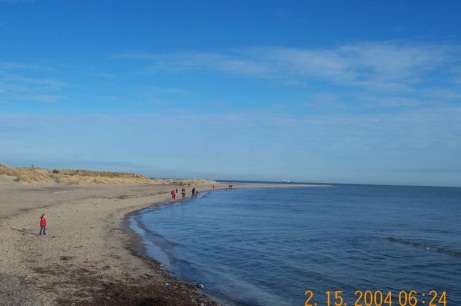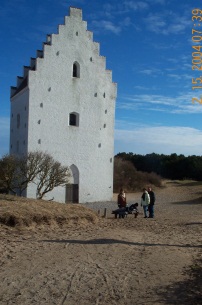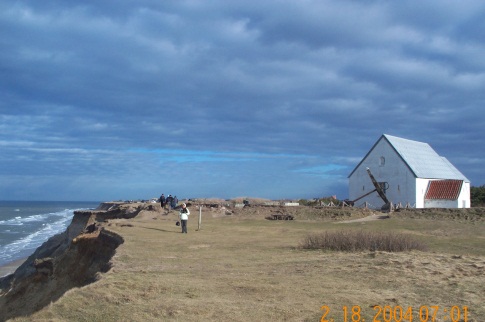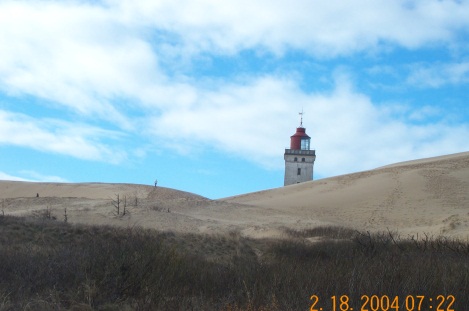As the Danish Sisterhood tour of Denmark is just months away, I was inspired to share some of my fond recollections of a trip to Skagen and Northern Jutland about 10 years ago.
During a family visit to Odense, we decided to make an excursion to some of the places we don’t normally visit. My husband wanted to experience Skagen and I had never seen Råbjerg Mile, a ”wandering sand dune” that I had learned about in elementary school, so we set out for the northern part of Jutland.
Skagen is the northernmost town in the Denmark, located on the very tip (Grenen) of the narrowest part of Jutland. Because of this unique location, there is only one road leading into the town, and the same road leading out, so you don’t have to worry about getting lost. It is a most interesting, quaint little town, which during the summer months it is a veritable Mecca for tourists. Skagen, of course, is a fishing town with a very busy harbor, but it is probably best known as a haven for artists.
During the latter part of the 19th and the beginning of the 20th century a group of painters – Anna and Michael Anchor, P. S. Krøyer, and Laurits Tuxen were among the most famous – as well as poets (Holger Drachman, whose tomb you’ll find among the dunes at Skagens Gren) and other writers were all living and working there and socializing with each other. Today the Klitgården (formerly a favorite summer residence of Queen Margrethe’s grandparents King Chrisitan X and Queen Alexandrine), located on the beach just south of the town has been turned into a “home” for budding artists and scientists.
When you go to Skagen as a tourist there are two things you must see. One is Grenen – the very tip of Jutland, where you usually can see the Kattegat and the Skagerrak come crashing together with tremendous force – although I’ve been there when it was as calm as can be – no excitement whatsoever! The very tip Grenen is a nice, brisk walk form the lighthouse, but if you’re not up for walking, you can take Sandormen (the “sand worm”) – a small “train” that drives you to the “end of Denmark” on the hard packed sandy beach. The other “must-see” is Den Tilsandede Kirke (the church that was buried by sand). Several hundred years ago there were furious sand storms in that area that ruined entire villages. While these villages are gone, the tower of Sct. Laurentii Kirke still remains, but only the top part of it is still visible above the sand
Even more impressive than the sights of Skagen – to me – was Råbjerg Mile – the wandering sand dune that reportedly “migrates” 15 meters towards the east each year. I have never seen so much sand in my life – all piled up in huge dunes. Råbjerg Mile is found about 10 miles south of Skagen and the dunes there can measure up to 41 meters in height. Trust me, climbing to the top of the dunes in the loose sand was hard work, but the view from the top made it well worth the climb. Some little kids were having a lot of fun rolling down the slope; it looked tempting, but I don’t think I’d have been too popular if I had returned to the car all covered in sand. The breeze was pretty stiff, so we got to see the sand in motion and ended up with quite a bit of grit in our teeth and sand in our shoes.
I had read about Mårup Church, and knew that it was on the west coast of northern Jutland, so we decided to include that in our outing. Mårup Kirke is an old church sitting high on a bluff above the North Sea. Due to the force of the waves the bluff is being eroded and part of the old cemetery behind the church has already fallen prey to the sea, and, eventually, so will the church as each big wind storm takes away a portion of the bluff.
From Mårup we continued a few miles south along the coast and came to Rubjerg Knude – another “sandy place” – where there, besides a “Sand Migration Museum”, is a lighthouse with an attached building. We could only assume that it at one time must have been the lighthouse keeper’s house, but it is now practically covered by sand, yet another victim of one of Mother Nature’s mighty forces. On the leeward side we could still see part of the wall and the windows. There were several feet of sand on the floor inside, but on the windward side of the building the sand came right up to the top of the roof.
Usually we don’t think of Denmark as being the target of nature’s power, but I’m sure the people of the northern and western parts of Jutland – the area from which most of the migration to America in the 19th century incidentally came – must have a great respect for the whims of Mother Nature.






